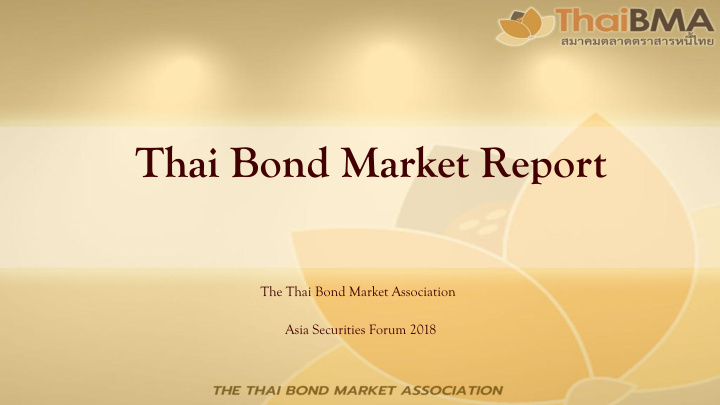



Thai Bond Market Report The Thai Bond Market Association Asia Securities Forum 2018
Thailand’s Financial Market (% of GDP) After the 1997 financial crisis, Thai Bond Market has significantly grown from 12% of GDP to 78% of GDP by end of August 2018 The growth of Thai Bond Market creates more balance among 3 main financial pillars (bank loan, equity and bond market), where the portion of equity has outperformed bank loan in the past 3 years. The size of Thai corporate bond has been continuously increasing, unaffected by 2008 subprime crisis. 2
Outstanding Value of Thai Bond Market At the end of August 2018, the outstanding value of Thai bond market totaled USD 369.59 billion, growing 4.54% from end of 2017. Government bond (38%) is the majority of the market, followed by BOT and corporate bonds sharing the same ratio at 27% of the market. Government sector bonds (Gov, BOT and SOE bonds) represent 72% of the market. 3 **FX USDTHB using each year-end closing from BOT source**
Trading Value of Thai Bond Market Trading value in Thai Bond Market (USD Million) (Avg. per day) USD Million Foreign Bond State Owned Enterprise Bond Corporate Bond Bank of Thailand Bond Government Bond Aug- 485.83 1,268.66 2,003.64 1,785.82 2,265.19 2,263.99 2,622.41 2,588.62 2,325.63 2,230.94 2,550.99 2,750.78 2,513.92 The average trading value per day of Thai bond market was USD 2,513.92 million by end of August 2018. BOT bonds are the most actively traded, having average trading value at USD 1,710.06 million per day. Approximately 93% of total trading value was attributed to government and BOT bonds. Trading value of corporate bonds have significantly been increasing since 2012. 4 **FX USDTHB using each year-end closing from BOT source**
Non-Resident Fund Flow Unit: USD mln Net Flow Period <=1Y Bond Accumulation >1Y Bond All Net Trading Expired Net Flow End of 2017 5,978 -4,334 1,645 5,144 6,789 6,789 Jan-18 1,219 -451 768 1,241 2,009 2,009 Feb-18 -315 -600 -915 322 -593 1,417 Mar-18 1,223 -1,515 -293 103 -190 1,227 Quarter 1 2,127 -2,567 -439 1,666 1,227 1,227 Apr-18 -933 -280 -1,213 178 -1,035 192 May-18 -467 -184 -651 657 6 198 Jun-18 52 -253 -200 149 -51 147 Quarter 2 -1,347 -716 -2,063 984 -1,080 147 Half year 1 780 -3,283 -2,503 2,650 147 147 Jul-18 -126 -208 -334 283 -51 96 Aug-18 935 -416 519 1,213 1,732 1,828 01-21/09/2018 190 -120 70 1,059 1,129 2,957 YTD 1,779 -4,027 -2,248 5,205 2,957 As of September 21 st , 2018 YTD fund flow from non-resident investors registered in net buying USD 2,957 million. Most of inflows were invested in long-term bonds, while there were outflows from short-term bonds. 5 **FX USDTHB using each period-end closing from BOT source**
Government and Corporate Bond Holders Corporate Bond Holders Government Bond Holders H1 2018: USD 85,827 mln H1 2018: USD 137,958 mln Non-residents Financial 0% Institutions Non-profit org. Non-profit org. Non- % 6% Government Financial 1% residents Institutions % Individual Pension Fund & % % Provident Fund Individual Corporate Mandatory 13% % 30% Provident Fund Mutual fund (exc. Gov.Agency, BOT % MMF) and SSO Corporate 12% % Insurances 8% Mutual fund Insurances 16% (excl. MMF) % % Gov.Agency, BOT Other depository and SSO FI. e.g. Other depository 4% Coop., MMF FI. e.g. % Coop., MMF 10% In the first half of 2018, top three government bond holders were insurance investors (28%), financial institutions (20%) and non-residents (16%). Top three corporate bond holders were individual (30%), insurance investors (16%) and government pension & provident fund (13%). 6
Challenges Ahead Review of corporate bond prospectus, terms & conditions, covenants and a strengthening of the roles and functions of bondholder representatives to enhance investor protection. The use of Distributed Ledger Technology (DLT) and Blockchain to allow for more secured and efficient record keeping and transfer of bonds to enhance efficiency and facilitating further growth in corporate bond market. 7
<Registrar Service Platform - Primary Market> 8
<Registrar Service Platform - Secondary Market> 9
Thank You 10
Recommend
More recommend